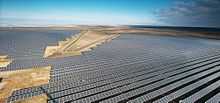Energy in Ukraine
Energy in Ukraine describes energy and electricity production, consumption and import in Ukraine. Ukraine's geographic position and proximity to Russia explain its importance as a natural gas and petroleum liquids transit country.
Approximately 3.0 trillion cubic feet (Tcf) of natural gas flowed through Ukraine in 2013 to Austria, Bosnia-Herzegovina, Bulgaria, Croatia, Czech Republic, Germany, Greece, Hungary, Moldova, Poland, Romania, Slovakia, and Turkey.[1]
Ukraine depends on Russia for its supplies of natural gas and oil (which are also produced domestically), although being net-exporter of electricity and coal. Ukraine tries to diversify energy sources.[2]
Overview
| Energy in Ukraine[3] | ||||||
|---|---|---|---|---|---|---|
| Capita | Prim. energy | Production | Import | Electricity | CO2-emission | |
| Million | TWh | TWh | TWh | TWh | Mt | |
| 2004 | 47.5 | 1,632 | 887 | 748 | 150 | 305 |
| 2007 | 46.4 | 1,597 | 949 | 693 | 164 | 314 |
| 2008 | 46.3 | 1,583 | 945 | 690 | 163 | 310 |
| 2009 | 46.0 | 1,343 | 894 | 487 | 147 | 256 |
| 2012 | 45.7 | 1,470 | 994 | 555 | 167 | 285 |
| Change 2004-2009 | -3.0 % | -17.7 % | 0.8 % | -34.9 % | -1.4 % | -15.9 % |
| Mtoe = 11.63 TWh, Prim. energy includes energy losses that are 2/3 for nuclear power[4] | ||||||
Gas
Ukraine was 6th top gas importer in 2009.[5]
Naftogaz is the state owned gas company. Ukraine buys gas from Russia. In disputes Russia has stopped gas delivery in 2006 and 2008. In 2009 80% of the European Union gas from Russia was delivered via Ukraine.
Coal
Electricity
Ukraine was 8th top nuclear electricity producer in 2009. 46.7% of domestic electricity generation was nuclear. This was the 2nd largest share, only France was higher.[5] The largest nuclear power plant in Europe is in Ukraine.
Energoatom (National Nuclear Energy Generating Company of Ukraine) is the state nuclear company founded 17.10.1996 in Kiev. Employees 38 000.
The 1986 Chernobyl disaster in Northern Ukraine was the world's most severe nuclear accident.
Lack of coal for Ukraine's coal-fired power stations due to the War in Donbass and a shut down one of the six reactors of the Zaporizhia Nuclear Power Plant lead to rolling blackouts throughout Ukraine from early till late December 2014.[6]
Corruption
Corruption is one of the top problems in Ukraine, characterised as a systemic phenomenon, which exists in all sections and levels of the public administration.[2] Ukraine gets gas from Gazprom via third parties. Gazprom did not publish any reporting on anti-corruption programmes.[7]
See also
| Wikimedia Commons has media related to Energy in Ukraine . |
References
- ↑ http://www.eia.gov/countries/country-data.cfm?fips=up''. Missing or empty
|title=(help); - ↑ 2.0 2.1 National Integrity System, Ukraine 2011 Transparency International
- ↑ IEA Key World Energy Statistics Statistics 2013, 2012, 2011, 2010, 2009, 2006 IEA October, crude oil p.11, coal p. 13 gas p. 15
- ↑ Energy in Sweden 2010. Facts and figures. The Swedish Energy Agency. Table 8 Losses in nuclear power stations Table 9 Nuclear power brutto
- ↑ 5.0 5.1 IEA Key statistics 2010
- ↑ Ukraine turns off reactor at its most powerful nuclear plant after 'accident', The Independent (28 December 2014)
Ukraine Briefly Cuts Power to Crimea Amid Feud With Russia Over NATO, New York Times (DEC. 24, 2014)
Coal import to help avoid rolling blackouts in Ukraine — energy minister, ITAR-TASS (December 31, 2014)
Rolling blackouts in Ukraine after nuclear plant accident, br>Mashable (Dec 03, 2014)
Ukraine to Import Coal From ‘Far Away’ as War Curtails Mines, Bloomberg News (Dec 31, 2014) - ↑ 2011 report on oil and gas companies, Promoting revenue Transparency Transparency International 2011
| ||||||||||||||||||||||||||||||||||||||||||||||||
| ||||||||||||||||||||||||||||
| ||||||||||||||||||
| ||||||||||||||||||
